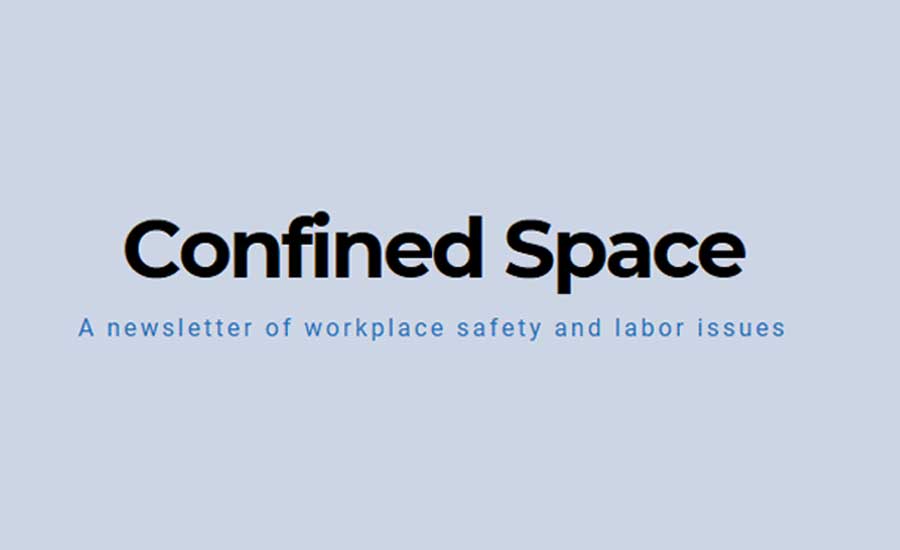Posted with permission from Confined Space, a newsletter of workplace safety and labor issues.
While most of the discussion of President Trump’s nomination of Brett Kavanaugh to the Supreme Court focuses on the possibility that he will be the deciding vote to repeal Rowe v. Wade or that the will bend over backwards to help Trump out of the Russia investigation, there is clear evidence that Kavanaugh is overly friendly to corporate America, and hostile to workplace safety, the Occupational Safety and Health Act and the environment.
In 2010 a killer whale dismembered and drowned a Sea World trainer, Dawn Brancheau, in front of hundreds of horrified men, women and children looking forward to a day of fun and frolic with sea animals. The whale that killed Brancheau had been implicated in three previous human deaths.
OSHA issued a $70,000 willful General Duty Clause Citation against Sea World and ordered the company to reduce the hazard by physically separating trainers from the whales. OSHA proved that Sea World and its employees knew from previous incidents and close calls that the all of its killer whales were dangerous, and that Tilikum, the whale that killed Brancheau, was particularly dangerous. Experts also described a feasible means of protecting employees — actions that Sea World in fact implemented following Brancheau’s death.
The Occupational Safety and Health Review Commission upheld OSHA’s citation, and Sea World appealed to the Court of Appeals. The D.C. Circuit court decided 2-1 in favor of OSHA. The Court found that “There was substantial record evidence that Sea World recognized its precautions were inadequate to prevent serious bodily harm or even death to its trainers and that the residual hazard was preventable,” and that there was substantial evidence that there were feasible means to protect employees without impacting the business. The majority opinion upholding OSHA’s action was written by Circuit Judge Judith Rogers. Also supporting OSHA was Chief Judge Merrick Garland.
The lone dissenter, opposing OSHA’s citation, was Circuit Judge Brett Kavanaugh.
According to former OSHA Assistant Secretary David Michaels, “In his dissent in the Sea World decision, Judge Kavanaugh made the perverse and erroneous assertion that the law allows Sea World trainers to willingly accept the risk of violent death as part of their job. He clearly has little regard for workers who face deadly hazards at the workplace.”
| "Judge Kavanaugh made the perverse and erroneous assertion that the law allows Sea World trainers to willingly accept the risk of violent death as part of their job. He clearly has little regard for workers who face deadly hazards at the workplace." — David Michaels |
Garland, as you may remember was nominated to the Supreme Court in 2016, following the death of Supreme Court Justice Antonin Scalia. Republicans, led by Senate Majority Leader Mitch McConnell, infamously refused to consider Obama’s nomination, allowing Trump to appoint Neil Gorsuch to the Court. And the lead attorney representing Sea World was Eugene Scalia, son of deceased Justice Antonin Scalia.
Are Whale Shows A Sport Like Football?
Kavanaugh calls OSHA’s action “arbitrary and capricious” because regulating the safety of killer whale shows is allegedly no different than regulating the safety of tackling in football, or speeding in sports car racing, or punching in boxing — things in which OSHA has never involved itself. And just as you’d have no football if you didn’t have tackling, or no sports car racing if you didn’t have speeding, there would allegedly be no Sea World if there was no close human contact with killer whales.
| Killer whale shows are not supposed to be modern gladiatorial contests where the audience looks forward to seeing whether the trainers will successfully keep their limbs attached or finish the show bleeding and dead at the bottom of a pool. |
One problem with this argument, as Rogers points out, is that no one — except Kavanaugh — claims that whale shows are a sport where you are there to see who “wins.”
Or, to put it more bluntly, people go to boxing matches to watch people punch each other, and go to football games to watch one team physically stop the other from scoring. But tourists — including small children — go to Sea World to watch attractive trainers lovingly interact with adorable sea creatures. Killer whale shows are not supposed to be modern gladiatorial contests where the audience looks forward to seeing whether the trainers will successfully keep their limbs attached or finish the show bleeding and dead at the bottom of a pool.
Not even Sea World made the football/car racing/boxing analogy, Rogers and Garland point out. By making that argument, Kavanaugh is just makin’ stuff up — adding his own opinions on matters that weren’t even part of the case.
Second, as the majority opinion points out, “physical contact between players is ‘intrinsic’ to professional football in a way that it is not to a killer whale show.” Spectators can take pleasure from a whale jumping out of the water and doing back flips even without close personal contact with a human trainer.
In fact, the show went on even after the OSHA citation. Following Brancheau’s death, Sea World implemented many of the controls that OSHA recommended in its General Duty Clause citation — and still managed to attract customers to the park — and even to the killer whale shows — without the close personal contact.
Hostility Toward OSHA
Kavanaugh’s dissent drips with hostility toward OSHA and a basic misunderstanding of the act and the principles — and law — behind it. Comparing killer whale shows to football, boxing, car racing, as well as other “extremely dangerous” sports such as “Ice hockey. Downhill skiing. Air shows. The circus. Horse racing. Tiger taming. Standing in the batter’s box against a 95 mile per hour fastball….” etc., etc., Kavanaugh objects to OSHA’s “paternalistic” intervention because “the participants in those activities want to take part.”
And then goes on to state (cue the heroic music)
He then asks
Not “the bureaucracy at the U.S. Department of Labor,” according to Kavanaugh.
Happily, Garland and Rogers were more knowledgeable about the Occupational Safety and Heath Act than Kavanaugh. They point out that the OSHAct puts the duty on the employer to create a safe workplace, not on the employees to choose whether or not they want to risk death — especially when the employer can make the workplace safer.
Kavanaugh’s idea of making America great again apparently hearkens back to a time before the Workers Compensation laws and the Occupational Safety and Health Act were passed. Back then employers who maimed or killed workers often escaped legal responsibility by arguing that the employee had “assumed” the risk when he or she took the job and the employer therefore had no responsibility to make the job safer. Maybe the worker even liked doing dangerous work. Employers also escaped responsibility by showing that the worker was somehow negligent. (Interestingly, Sea World originally blamed Brancheau for her own death because she hadn’t tied her hair back.)
| Kavanaugh’s idea of making America great again apparently hearkens back to a time before the Workers Compensation laws and the Occupational Safety and Health Act were passed. |
Rogers and Garland were forced to remind Kavanaugh that the employer’s duty under the OSHAct isn’t reduced by “such common law doctrines as assumption of risk, contributory negligence, or comparative negligence.”
Workers Comp laws, originally passed in the early 20th century, were supposed to be no-fault. It didn’t matter who was at fault, if the worker was hurt, the worker got compensated. And the OSHAct, passed in 1970, further states clearly and unequivocally that the employer is responsible for ensuring that the workplace is “free from recognized hazards that are causing or are likely to cause death or serious physical harm to his employees,” and sets up a mechanism to enforce the law and penalize employers who violated it. Even if the macho employee wants to defy death, the law states that the workers may not work at heights without fall protection or go down into deep trenches without shoring. And it’s the employer’s job to make sure that employees are not endangered.
Did Brancheau enjoy her job? Undoubtedly.
Did she “willingly accept the risk of violent death as part of their job?” Unlikely. And legally irrelevant.
Did she deserve a safe workplace? Absolutely.
Nothing New Under the Sun?
Kavanaugh also objected to OSHA’s citation because the agency allegedly “departed from tradition and stormed headlong into a new regulatory arena.”
Well, first, Congress put the General Duty Clause into the OSHAct to address “unique” recognized hazards for which there is no OSHA standard.
Second, objecting to OSHA “storming into a new arena” brings back memories of the arguments used by previous OSHA heads, politicians and the health care industry when unions petitioned the agency in the late 1980’s for a bloodborne pathogens standard to prevent HIV infection and over 300 health care worker deaths a year from hepatitis B. At that time, infectious diseases were “a new regulatory arena.” Thankfully, Judge (or Justice) Kavanaugh wasn’t around then to rule on that standard. Thousands of health care workers owe their lives to OSHA’s move into the “new regulatory arena” of infectious diseases.
Bad for the Environment
Ken Ward of the Charleston Gazette-Mail reminds us that Kavanaugh is not only anti-worker (and anti-OSHA), but also anti-environment (and anti-EPA). In 2011, Kavanaugh was the lone dissenter in a case where Arch Coal had challenged the Environmental Protection Agency’s authority to cancel a mountain-top removal permit that had been issued by the U.S. Army Corps of Engineers. The 2,300-acre Spruce operation that would have buried more than seven miles of streams. “The EPA cited the growing scientific evidence that mountaintop removal mining significantly damages water quality downstream and noted an independent engineering study that found Arch Coal could have greatly reduced the Spruce Mine’s impact.”
Kavanaugh’s argument is that EPA didn’t do a proper cost benefit analysis. Suddenly becoming a champion of working people and unions (at least when it benefits the company), Kavanaugh argued that EPA had failed to factor in the costs of putting more than 300 United Mine Workers union members out of work. Once again, Kavanaugh was making stuff up (legally). Arch Coal hadn’t even made that argument.
Kavanaugh also criticized the agency’s examination of potential damage to aquatic life as an “utterly one-sided analysis.” Perhaps the fish had also “accepted the risk” of living in streams near coal deposits.
One of the judges in the majority was an Ronald Reagan pick, and the other was appointed by President Obama.
Conclusion
Kavanaugh stated at last night’s press conference that one of his legal principles is that “A judge must interpret statutes as written.” He might have added that to interpret the law as written, one must first read and understand the law.
He also warmly told the world that his mother was a prosecutor whose trademark line was: “‘Use your common sense. ‘What rings true? What rings false?’ That’s good advice for a juror and for a son. ”
Indeed it is. And maybe he could explain to the parents and husband of Dawn Brancheau why it rings false to him that the company responsible for their daughter’s safety should be held responsible for her death — and held to the same standard as every other employer in the country.
Until he does that, he doesn’t belong on the Supreme Court.
Click here to visit Confined Space.
Click here to donate to Confined Space.



